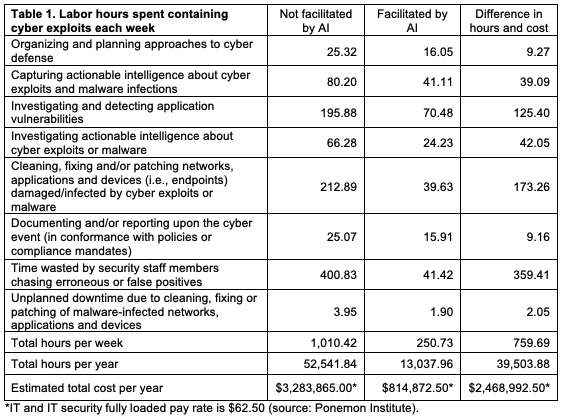The advent of AI is changing IT and will continue to change in the future.
The basic tenets of AI-enabled programs are that they can collect data, analyze it, make a decision with an understanding of outcomes, and learn from the results. That is why applying AI to cybersecurity brings new defensive promises and offensive challenges to cybersecurity.
Cybersecurity is taking center stage because the exponential increase in data (consumer and business) has made data breaches more common. Some of the most common causes of data breaches are;
- Weak or stolen security credentials, like passwords
- Malware in the form of viruses, ransomware, phishing scams.
- Social engineering
- Insider threats
- Improper IT system configuration and user error
- Back doors through vulnerable applications and
- Maladministration of permissions
The increasing number of attacks has encouraged the adoption of AI in cybersecurity to bring efficiency and accuracy data defenses. Expectedly, AI has also given new capabilities to bad actors.
AI makes it easier to build smart defenses and threats.

In the past, hackers were highly skilled programmers who could code their malware and navigate sophisticated security protocols. That is no longer the case; malware can now be sold as an intelligent solution that only requires a plug and play. This brings non-computer expert hackers into the fray and ultimately increases the number of hackers.
Defending against such simple-to-use smart threats needs an intelligent solution. For example, using an AI-based network-monitoring tool, security vulnerabilities can be identified quickly by analyzing user behaviors, recognizing patterns and identifying irregularities in the network, and reacting accordingly. It can detect, monitor, and close more cyber attack vectors than is humanly possible.
This is how it works: AI models will ingest high volume data of every application in the organization at all endpoints to develop a profile. This helps to establish a baseline of behavior, so should there be a statistically significant deviation from the norm, the algorithm will flag it for further investigation.
AI can also boost biometric authentication.

One of the pain points for digital users has been conceiving, remembering, and regularly changing strong passwords. This pain point has been used by hackers to infiltrate and compromise secure data. This loophole can be closed by biometric logins that use either scanning fingerprints, retinas, or palm prints. Biometric logins can be used alone or with a password to control and monitor access.
Automation is now being applied to malware. Rather than have a direct hacker attack personally, they can now have automated malware operating with minimum human input. The automation of malware is making them more frequent, sophisticated, and relentless.
Automated malware is a threat to IoT devices, and security breaches are expected to increase exponentially with increased use. IoT devices are a particular concern as manufacturers do not prioritize security when making the product, and consumers rarely think of security when connecting the devices. This has made IoT devices a top target for internet attack traffic.
Automation can save cybersecurity teams time and money. Cybersecurity teams perform a lot of routine tasks that need to be automated. IT administrators are continuously inundated with recurring incidents, insider threats, and device management responsibilities that take time away from more critical tasks. Automating these mundane tasks will not only free up human capital resources but will achieve results in a fraction of the time and at higher accuracy.

Machine learning will make threat hunting adaptable to evolving malware.

Malware is usually a program with a rigid purpose or protocol. Hackers can apply AI to their programming to adapt and learn from each attack. The AI-enabled malware could also mimic human or trusted elements of the IT system to gain entry. This makes it easier to build polymorphic malware with obfuscation features.
A key asset in malware detection is virus definitions or databases that carry malware identifiers and patterns that help to recognize threats. Machine learning can be used by bad actors to evade detection, but it can also be used by IT to identify risks quickly.
Cybercriminals usually tweak their malware code to get past security software. Identifying every variation of deliberately disguised malware is hard. A malware database with machine-learning can detect malware, whether it is an existing or tweaked malware, and the system can block it based on previous events deemed malicious.
Identifying continuously evolving threats is easier with AI. AI systems can be trained to detect ransomware and malware attacks before they enter the system. Once discovered, they can then be isolated from the system. The predictive functions of AI surpass the speed of traditional approaches.
The use of machine learning in cybersecurity can bring benefits such as:
- Monitoring and analyzing multiple endpoints for cyber threats
- Detecting malicious activity before they manifest into a full-fledged attack
- Automation of routine security tasks
- Eliminating zero-day vulnerabilities
AI-enabled cybersecurity is essential.
Capgemini Research Institute found that two thirds (69%) of organizations acknowledge that they will not be able to respond to critical threats without AI. Over half (56%) of executives say their cybersecurity analysts are overwhelmed by the vast array of data points they need to monitor to detect and prevent intrusion. Also, the type of cyberattacks that require immediate intervention, or that cannot be remediated quickly enough by cyber analysts have notably increased, including:
- Cyberattacks are affecting time-sensitive applications (42% saying they had gone up, by an average of 16%).
- Automated, machine-speed attacks that mutate at a pace that cannot be neutralized through traditional response systems (43% reported an increase, by an average of 15%).
AI is already being applied to cybersecurity. Some of the AI cybersecurity applications currently in use include;
- Spam filter applications
- Network intrusion detection and prevention
- Fraud detection
- Botnet detection
- Secure user authentication
- Hacking incident forecasting
Although an organization’s security system may be secure, since it interacts with third parties (customers, regulators, suppliers, etc.), it is vulnerable through these pathways. According to Accenture, 40% percent of security breaches are indirect, as threat actors target the weak links in the supply chain or business ecosystem. That is why organizations need an automated intelligent solution that can predict attacks and respond quickly.



